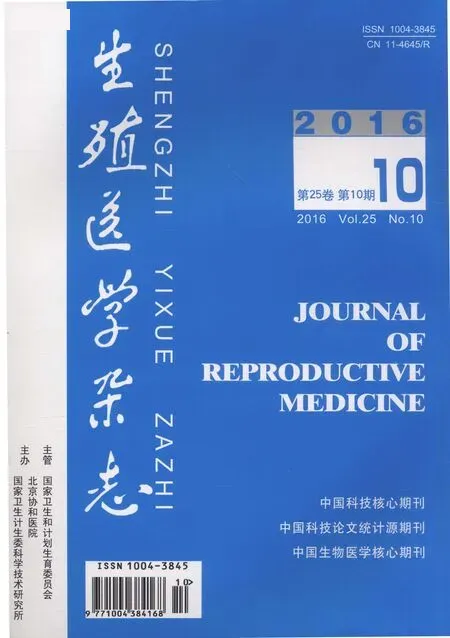单囊胚冷冻复苏周期中囊胚时期及质量与临床结局相关分析
倪晓蓓,王珊珊,张宁媛,孙海翔
(南京大学医学院附属鼓楼医院生殖医学中心,江苏南京 210008)
·临床研究·
单囊胚冷冻复苏周期中囊胚时期及质量与临床结局相关分析
倪晓蓓,王珊珊,张宁媛,孙海翔*
(南京大学医学院附属鼓楼医院生殖医学中心,江苏南京210008)
目的比较囊胚时期及囊胚质量在单囊胚冷冻复苏周期中与临床结局的关系。方法回顾性分析2014年1 月至2015 年12月在本中心进行单囊胚冷冻复苏周期的患者,总例数为243例;分析研究囊胚时期及囊胚质量对临床结局的影响。结果囊胚时期及囊胚质量与临床结局有相关性:囊胚移植D5与D6植入率(61.14%vs.44.00%)和临床妊娠率(60.62%vs.44.00%)有显著性差异(P<0.05);优质囊胚与非优质囊胚植入率(66.94%vs.47.90%)和临床妊娠率(66.94%vs.47.06%)亦有显著性差异(P<0.01)。患者的年龄、体重指数、基础激素水平、内膜厚度、流产率、异位妊娠率等均无统计学意义(P>0.05)。结论单囊胚冷冻复苏时可以优先考虑D5优质囊胚移植。
单囊胚冷冻复苏;囊胚时期;囊胚质量;临床结局
Methods:The data of 243 cryopreserved single blastocyst transfer cycles at the Reproductive Center from January 2014 to December 2015 were retrospectively analyzes. The clinical outcomes were compared among the blastocysts with different development periods and scoring parameters.
Results:Totally,the development periods & quality of blastocysts significantly impacted clinical pregnancy (P<0.05). The implantation rate(61.14% vs. 44.00%)and pregnancy rate (60.62% vs. 44.00%)of Day 5 and Day 6 blastocysts were significantly different (P<0.05). The implantation rate(66.94% vs. 47.90%)and pregnancy rate(66.94% vs. 47.06%)of high quality and non-quality blastocysts were also significantly different (P<0.01). There was no significance in age,body mass index,baseline hormone levels,endometrial thickness of the patients among the groups (P>0.05).
Conclusions:The transfer with high quality blastocysts on Day5 should be prioritized in cryopreserved single blastocyst transfer cycles.
(JReprodMed2016,25(10):926-931)
随着胚胎培养技术的发展,囊胚培养的成功率得到改善,现已证实囊胚移植较卵裂期胚胎移植的临床妊娠率高[1-3],Papanikolaou等[4]研究表明高评分的卵裂期胚胎培养至囊胚后移植相比高评分卵裂期胚胎移植组具有更好的妊娠率和活产率,近年来越来越多的辅助生殖中心开展单囊胚移植以期降低多胎率的同时维持可观的妊娠率。囊胚冷冻前的人工皱缩技术的发展使得冷冻复苏囊胚移植获得了与新鲜囊胚移植相似的活产率[5-6],大大推进了囊胚冷冻复苏技术在辅助生殖技术中的应用,但是如何在冷冻复苏周期中挑选最佳发育潜能的囊胚还有待进一步研究。目前沿用的囊胚质量评分系统由Gardner等[7]提出,基于内细胞团、滋养外胚层形态和扩张等级三个参数。关于囊胚质量和囊胚时期对囊胚移植临床结局的影响目前还存在争议[8-10],而如何选择最佳的囊胚进行移植关乎每对不孕夫妇的妊娠结局,这在单囊胚移植技术的推广中尤为重要,因此,本研究旨在评估单囊胚冷冻复苏周期中囊胚时期、囊胚质量与临床结局的相关性,以期为临床应用提供有效的参考。
资料和方法
一、研究对象
2014年1月至2015年12月在本院生殖医学中心行辅助生殖治疗的单囊胚冷冻复苏周期患者。为减小其他因素的影响,患者纳入研究标准:(1)在本中心行 IVF 助孕的患者,且为单囊胚冷冻复苏周期;(2)年龄≤40岁;(3)夫妻双方染色体核型分析正常;(4)内膜准备方案为HRT方案,排除中重度子宫内膜异位症、子宫畸形、子宫多发性息肉患者。其中D5囊胚移植组193例;D6囊胚移植组50例。所有患者夫妻双方均理解并签署知情同意书。
二、研究方法
1. 治疗方案:用常规促排卵方案进行卵巢刺激,B超监测卵泡生长发育,待主导卵泡直径达18~20 mm当晚注射HCG 250 μg(默克雪兰诺,德国)或HCG10 000 IU(丽珠医药),间隔 36 h左右在B超引导下严格按照无菌要求穿刺取卵。
2. IVF:均采用短时受精,将卵丘复合物采集后置 IVF (Vitrolife,Sweden)微滴中培养3 h,加入精子(1×104/卵),通过观察第二极体的形成判断受精。
3.受精、卵裂的观察和冷冻胚胎的筛选:受精后置于G1(Vitrolife,Sweden)序贯培养液中培养,16~18 h观察原核形成。取卵后48 h观察卵裂情况,于72 h选择优质胚胎移植、冷冻或将Day3的分裂期胚胎转入囊胚培养液G2 (Vitrolife,Sweden)微滴中,继续培养至Day5,观察囊胚发育情况。根据Garnder囊胚分级法对囊胚进行分级[6],本中心将评分≥3BC或≥3CB的囊胚定为可冷冻囊胚。
4.囊胚冷冻与复苏冷冻基础液:本中心配置方法:羟乙基哌嗪乙磺酸(HEPES)缓冲的合成人输卵管液(mHTF)中添加20%人血清蛋白(SSS,SAGE);冷冻液Ⅰ:mHTF中添加10%乙二醇(EG,Sigma,Germany)+10%二甲基亚砜(DMSO,Sigma,Germany);冷冻液Ⅱ:mHTF中添加20%EG+20%DMSO+0.3 mol/L蔗糖(Sigma,Germany)。解冻液Ⅰ:mHTF中添加20%SSS+1 mol/L蔗糖;解冻液Ⅱ:mHTF中添加20%SSS+0.5 mol/L蔗糖;解冻液Ⅲ:mHTF中添加20% SSS+0.25 mol/L蔗糖;解冻液Ⅳ:mHTF中添加20%SSS。囊胚冷冻:将囊胚置于 G2 培养液(Vitrolife,Sweden) 30 μl 培养液滴内,利用激光破膜仪系统进行人工皱缩,待囊腔近乎完全皱缩后移入基础冷冻平衡液,2 min后,先移入冷冻液Ⅰ中10 min,再移入冷冻液Ⅱ,60 s内装载至冷冻载杆的塑料薄膜片上并直接投入液氮中保存。胚胎复苏:37℃下,直接将载杆的塑料薄膜片迅速浸入解冻液Ⅰ,使胚胎滑落入培养液中。1 min后,按照浓度梯度递减的顺序,将胚胎在室温下依次移入解冻液Ⅱ、解冻液Ⅲ、解冻液Ⅳ,并分别停留3、5、5 min,最后在37℃下将解冻液Ⅳ中的胚胎移入胚胎培养液(G2),于37℃、5%O2、6%CO2培养箱中培养2 h并观察囊胚恢复情况后移植。
5. 子宫内膜的准备:患者从月经周期第 1天开始持续用补佳乐6 mg/d,月经周期第14天日开始监测子宫内膜厚度,当子宫内膜厚度超过8 mm,肌肉注射黄体酮60 mg,每日一次,囊胚于黄体酮注射后6 d移植。
6. 妊娠结局的判定、黄体支持及妊娠判定:胚胎移植后常规黄体支持,移植后14 d检测血HCG阳性,4~6周B超检查见孕囊及原始心管搏动视为临床妊娠。
三、统计学方法

结 果
一、患者基本资料及囊胚时期、囊胚质量与临床结局的关系
两组患者一般情况比较无统计学差异(P>0.05)(表1)。
二、不同囊胚时期移植组患者临床妊娠结局比较
囊胚时期(按D5囊胚移植、D6囊胚移植分组)、囊胚质量(按优质囊胚移植、非优质囊胚移植分组)与临床妊娠率的关系有统计学意义(P<0.05)D5囊胚移植者的种植率和临床妊娠率均高于D6囊胚移植者(P<0.05),而两组患者双胎率、畸形率、流产率、异位妊娠率等情况均无统计学差异(P>0.05)(表2)。
三、不同质量囊胚移植组患者临床妊娠结局比较
优质的囊胚移植组植入率、临床妊娠率均高于非优质囊胚组(P<0.05),而两组的双胎率、畸形率、流产率、异位妊娠率无统计学差异(P>0.05)(表3)。

表1 患者一般情况比较(x-±s)

表2 D5囊胚移植组与D6囊胚移植组患者临床妊娠结局比较[n,(%)]
注:与D6囊胚移植组比较,*P<0.05

表3 优质囊胚移植组与非优质囊胚移植组患者临床妊娠结局比较[n,(%)]
注:与非优质囊胚移植组比较,**P<0.01
讨 论
随着人类辅助生殖技术的发展,多胎已成为其重要的并发症之一,多胎会增加孕妇妊娠及新生儿出生的风险,文献报道在辅助生殖治疗中多胎率的发生与女方年龄、治疗过程等密切相关,其中一个关键的因素就是目前治疗中用多胚胎移植的方法来提高妊娠率的临床策略,因此在临床实践中推广单胚胎移植是解决这一问题的有效方法,而囊胚期的单胚胎移植将是较好的选择[11-12]。有文献报道囊胚移植与子宫内膜的同步性更好,从而有利于提高妊娠率[13],此外,囊胚的形成需要延长体外培养时间,从而可以筛选出发育潜能更好的胚胎用于移植或冷冻,更有利于妊娠,囊胚培养挑选出了最佳发育潜能的胚胎。有报道显示达到冷冻标准的顶级第三天胚胎有59%具有基因学的异常,而达到冷冻标准的顶级囊胚35%有基因学的异常[14],开展囊胚移植淘汰了部分具有遗传缺陷的胚胎,这将有助于提高妊娠率,Papanikolaou等[2,15]报道在鲜胚移植中单囊胚移植较单分裂胚移植有更高的活产率。但是这也不能完全避免染色体异常而形态学正常的囊胚被移植[16],结合种植前基因学诊断可以有效的筛选染色体正常的囊胚进行移植,提高植入率和妊娠率[17-18]。同时囊胚培养也可能会增加某些患者的风险,导致无可移植胚胎的情况[13]。也有学者对两种时期移植的出生儿结局做了调查,单因素回归分析的结果发现囊胚移植、促排卵方案、供卵都可能增加同卵双生的比率,而在多因素回归分析中发现囊胚移植与同卵双生的发生率更相关,但是具体机制还有待研究[19]。在辅助生殖中同卵双生的比率在1.2%~8.9%[19],本结果由于受样本量的局限,还未有相关的发现,后期会继续观察研究。因此,关于胚胎移植时期的选择还是要根据患者情况进行,目前在辅助生殖临床工作中,由于一些特殊情况的需要如预防严重OHSS的发生、患者鲜胚移植日阴道感染等,能否开展单囊胚冷冻复苏周期移植成为广大患者和工作人员关注的焦点,本研究旨在评估单囊胚冷冻复苏周期中囊胚时期、囊胚质量与临床结局的相关性,以期为临床单囊胚冷冻复苏周期的推广提供有效的参考。
关于囊胚质量与妊娠结局的关系的研究还存在争议[20-23]。目前沿用的囊胚质量评分系统由Gardner等[7]提出,基于内细胞团、滋养外胚层形态和扩张等级三个参数。一些研究者认为内细胞团等级与临床妊娠率呈正相关,内细胞团质量越好妊娠结局越好[24],然而,Hill等[25]和Thompson等[26]通过研究表明,在新鲜移植周期和冷冻复苏周期中滋养外胚层质量越好则临床妊娠率和活产率越高。此外,Ahlstrom等[27]和Abbeel等[28]研究表明依据囊胚腔扩张的等级可以预测单囊胚移植后的临床结局。在本研究纳入的243例单囊胚冷冻复苏移植患者中,均是用常规促排卵方案的IVF患者,依据患者的知情同意开展单囊胚冷冻复苏移植。本研究表明在单囊胚冷冻复苏周期中囊胚质量与临床结局的关系有统计学差异,内细胞团和滋养层质量优质的囊胚无论是植入率还是临床妊娠率均高于非优质囊胚组,而两组的多胎率、畸形率、流产率无统计学差异,提示在临床实践中应优先挑选优质囊胚进行移植。至于为什么优质囊胚具有更好的临床结局相关机制还有待于进一步研究。有报道提示优质囊胚的非整倍体率要低于非优质囊胚[29-30],而非整倍体的比率与流产的发生相关[31-32],值得注意的是在本结果中优质囊胚移植组的流产率与非优质囊胚移植组的差异有趋势但无统计学意义(10.84% vs. 12.50%),可能与本研究样本量偏小有关,预计将进行后续的追踪。
关于究竟是移植D5囊胚还是D6囊胚更具优势目前还存在争议[8-10],Dessolle等[33]认为D5囊胚移植的健康婴儿出生率显著高于 D6囊胚移植,建议避免 D6 移植,认为囊胚时期是关乎妊娠结局的重要因素。Muthukumar等[34]研究发现D5囊胚移植的临床妊娠率和植入率均高于 D6 囊胚移植;王雪等[35]发现D5囊胚的种植率、活产率高于D6囊胚,但无统计学差异。本研究结果表明在冷冻复苏周期中囊胚时期影响妊娠结局,D5囊胚移植者的种植率和临床妊娠率均高于D6囊胚移植者,而两组患者年龄、BMI值、基础内分泌、流产率、异位妊娠率等情况均无统计学差异,与已报道的研究结果[34]是一致的,因此针对这部分患者在选择囊胚移植时可以优选D5囊胚从而改善临床妊娠结局。有研究认为D6囊胚的发育潜能要低于D5囊胚,这可能是D5囊胚移植结局好于D6囊胚的原因之一[36]。也有文献提示D5囊胚的非整倍体率要低于D6囊胚(53.3% vs. 60.2%),但是这种差异无统计学意义[29]。因此,相关机制还有待进一步研究。
综上所述,对于单囊胚冷冻复苏周期的患者,在选择囊胚移植时,为了使患者利益最大化,在临床实践中应该诊视每一枚形成的囊胚,同时根据实际情况可以首先优选D5优质囊胚进行移植,本研究的结果将为推动冷冻复苏周期单囊胚移植提供有效的临床依据。但是由于本研究是小样本的回顾性研究,囊胚选择的数据主要基于本中心现有的标准,结果还存在局限性,待后续研究。
[1]Aziminekoo E,Mohseni Salehi MS,Kalantari V,et al. Pregnancy outcome after blastocyst stage transfer comparing to early cleavage stage embryo transfer[J]. Gynecological Endocrinology,2015,31:880-884.
[2]Papanikolaou EG,Camus M,Kolibianakis EM,et al. In vitro fertilization with single blastocyst-stage versus single cleavage-stage embryos[J]. N Engl J Med,2006,354:1139-1146.
[3]Santos MJ,Mercader A,Galan A,et al. Implantation rates after two,three,or five days of embryo culture[J]. Placenta,2003,24(Suppl B):S13-19.
[4]Papanikolaou EG,Elke DH,Greta V,et al. Live birth rate is significantly higher after blastocyst transfer than after cleavage-stage embryo transfer when at least four embryos are available on day 3 of embryo culture. A randomized prospective study[J]. Hum Reprod,2005,20:3198-3203.
[5]Evans J,Hannan NJ,Edgell TA,et al. Fresh versus frozen embryo transfer:backing clinical decisions with scientific and clinical evidence[J]. Hum Reprod Update,2014,20:808-821.
[6]Roy TK,Bradley CK,Bowman MC,et al. Single-embryo transfer of vitrified-warmed blastocysts yields equivalent live-birth rates and improved neonatal outcomes compared with fresh transfers[J]. Fertil Steril,2014,101:1294-1301.
[7]Gardner DK,Lane M,Stevens J,et al. Blastocyst score affects implantation and pregnancy outcome:towards a single blastocyst transfer[J]. Fertil Steril,2000,73:1155-1158.
[8]Liebermann J,Tucker MJ. Comparison of vitrification and conventional cryopreservation of day 5 and day 6 blastocysts during clinical application[J]. Fertil Steril,2006,86:20-26.
[9]Levens ED,Gustofson RL,Hennessy S,et al.Implantation rate and pregnancy outcomes are significantly improved in cryopreserved blastocyst transfers when frozen at day 5 compared to day 6[J]. Fertil Steril,2006,86:S256-S257.
[10]Richter KS,Shipley SK,Ingrid MV,et al. Cryopreserved embryo transfers suggest that endometrial receptivity may contribute to reduced success rates of later developing embryos[J]. Fertil Steril,2006,86:862-866.
[11]Bhattacharya S,Kamath MS. Reducing multiple births in assisted reproduction technology[J]. Best Pract Res Clin Obstet Gynaecol,2014,28:191-199.
[12]Messinis IE,Ekaterini D. What is the most relevant standard of success in assisted reproduction? Should BESST really be the primary endpoint for assisted reproduction?[J]. Hum Reprod,2004,19:1933-1935.
[13]Maheshwari A,Hamilton M,Bhattacharya S. Should we be promoting embryo transfer at blastocyst stage?[J/OL]. Reprod Biomedi Online,2015,32:142-146.
[14]Magli MC,Jones GM,Gras L,et al. Chromosome mosaicism in day 3 aneuploid embryos that develop to morphologically normal blastocysts in vitro[J]. Hum Reprod,2000,15:1781-1786.
[15]Papanikolaou EG,Kolibianakis EM,Tournaye H. Live birth rates after transfer of equal number of blastocysts or cleavage-stage embryos in IVF. A systematic review and meta-analysis[J]. Hum Reprod,2008,23:91-99.
[16]Fragouli E,Alfarawati S,Spath K,et al. Morphological and cytogenetic assessment of cleavage and blastocyst stage embryos[J]. Mol Hum Reprod,2014,20:117-126.
[17]Forman EJ,Upham KM,Cheng M,et al.Comprehensive chromosome screening alters traditional morphology-based embryo selection:a prospective study of 100 consecutive cycles of planned fresh euploid blastocyst transfer[J]. Fertil Steril,2013,100:718-724.
[18]Scott RT,Upham KM,Forman EJ,et al. Blastocyst biopsy with comprehensive chromosome screening and fresh embryo transfer significantly increases in vitro fertilization implantation and delivery rates:a randomized controlled trial[J]. Fertil Steril,2013,100:697-703.
[19]Luke B,Brown MB,Wantman E,et al.. Factors associated with monozygosity in assisted reproductive technology pregnancies and the risk of recurrence using linked cycles[J]. Fertil Steril,2014,101:683-689.
[20]Racowsky C,Combelles CM,Nureddin A,et al. Day 3 and day 5 morphological predictors of embryo viability[J/OL]. Reprod Biomed Online,2003,6:323-331.
[21]Kresowik JD,Sparks AE,Van Voorhis BJ. Clinical factors associated with live birth after single embryo transfer[J]. Fertil Steril,2012,98:1152-1156.
[22]甄璟然,王雪,孙正怡,等. 复苏单囊胚移植周期中囊胚形态学评分对临床妊娠的影响[J]. 生殖医学杂志,2014,23:7-10.
[23]王雅琴,杨菁,徐望明,等. 低等级胚胎囊胚培养及冻融周期移植后临床结局分析[J]. 生殖医学杂志,2015,24:220-224.
[24]Goto S,Kadowaki T,Tanaka S,et al. Prediction of pregnancy rate by blastocyst morphological score and age,based on 1,488 single frozen-thawed blastocyst transfer cycles[J]. Fertil Steril,2011,95:948-952.
[25]Hill MJ,Richter KS,Heitmann RJ,et al. Trophectoderm grade predicts outcomes of single-blastocyst transfers[J]. Fertil Steril,2013,99:1283-1289.e1.
[26]Thompson SM,Onwubalili N,Brown K,et al. Blastocyst expansion score and trophectoderm morphology strongly predict successful clinical pregnancy and live birth following elective single embryo blastocyst transfer (eSET):a national study[J]. J Assist Reprod Genet,2013,30:1577-1581.
[27]Ahlstrom A,Westin C,Wikland M,et al.Prediction of live birth in frozen-thawed single blastocyst transfer cycles by pre-freeze and post-thaw morphology[J]. Hum Reprod,2013,28:1199-1209.
[28]Abbeel EVD,Balaban B,Ziebe S,et al. Association between blastocyst morphology and outcome of single-blastocyst transfer[J/OL]. Reprod Biomed Online,2013,27:353-361.
[29]Antonio C,Laura R,Danilo C,et al. Correlation between standard blastocyst morphology,euploidy and implantation:an observational study in two centers involving 956 screened blastocysts[J]. Hum Reprod,2014,29:1173-1181.
[30]Samer A,Elpida F,Pere C,et al. The relationship between blastocyst morphology,chromosomal abnormality,and embryo gender[J]. Fertil Steril,2011,95:520-524.
[31]Stephenson MD,Awartani KA,Robinson WP. Cytogenetic analysis of miscarriages from couples with recurrent miscarriage:a case-control study[J]. Hum Reprod,2002,17:446-451.
[32]Fritz B,Hallermann C,Olert J,et al. Cytogenetic analyses of culture failures by comparative genomic hybridisation (CGH)-Re-evaluation of chromosome aberration rates in early spontaneous abortions[J]. Eur J Hum Gene,2001,9:539-547.
[33]Dessolle L,Freour T,Ravel C,et al. Predictive factors of healthy term birth after single blastocyst transfer[J]. Hum Reprod,2011,26:1220-1226.
[34]Muthukumar K,Kamath MS,Mangalaraj AM,et al. Comparison of clinical outcomes following vitrified warmed day 5/6 blastocyst transfers using solid surface methodology with fresh blastocyst transfers[J]. J Hum Reprod Sci,2013,6:59-64.
[35]王雪,甄璟然,孙正怡,等. 囊胚发育速度对冻融移植结局的影响[J]. 生殖医学杂志,2014,23:356-360.
[36]Voorhis BJ,Dokras A. Delayed blastocyst transfer:is the window shutting?[J]. Fertil Steril,2008,89:31-32.
[编辑:谷炤]
Development periods and quality of blastocysts impact clinical outcomes in cryopreserved single blastocyst transfer cycles
NI Xiao-bei,WANG Shan-shan,ZHANG Ning-yuan,SUN Hai-xiang*
CenterofReproductiveMedicine,DrumTowerHospitalAffiliatedtoNanjingUniversitySchoolofMedicine,Nanjing210008
Objective:To assess cycle outcome among the blastocysts with different development periods and scoring parameters in cryopreserved single blastocyst transfer cycles.
Cryopreserved single blastocyst transfer cycle;Development periods of blastocyst;Blastocysts quality;Clinical outcomes
10.3969/j.issn.1004-3845.2016.10.014
2016-03-24;
2016-04-24
倪晓蓓,女,江苏南通人,硕士,研究实习员,主要从事生殖医学研究.(*

